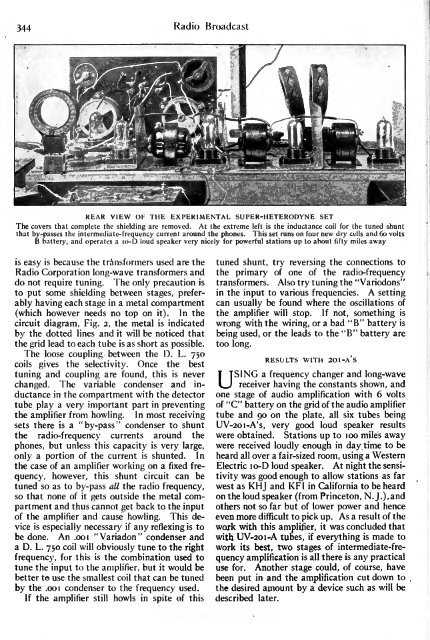Radio Broadcast - 1923, August - 86 Pages, 8.5 ... - VacuumTubeEra
Radio Broadcast - 1923, August - 86 Pages, 8.5 ... - VacuumTubeEra
Radio Broadcast - 1923, August - 86 Pages, 8.5 ... - VacuumTubeEra
- No tags were found...
Create successful ePaper yourself
Turn your PDF publications into a flip-book with our unique Google optimized e-Paper software.
etween344 <strong>Radio</strong> <strong>Broadcast</strong>REAR VIEW OF THE EXPERIMENTAL SUPER-HETERODYNE SETThe covers that complete the shielding are removed. At the extreme left is the inductance coil for the tuned shuntthat by-passes the intermediate-frequency current around the phones. This set runs on four new dry cells and 60 voltsB battery, and operates a lo-D loud speaker very nicely for powerful stations up to about fifty miles awayiseasy is because the transformers used are the<strong>Radio</strong> Corporation long-wave transformers anddo not require tuning. The only precautionisto put some shielding between stages, preferablyhaving each stage in a metal compartment(which however needs no top on it). In thecircuit diagram, Fig. 2, the metal is indicatedbythe dotted lines and it will be noticed thatthe grid lead to each tube is as short as possible.The loose .coupling the D. L. 750coils gives the selectivity. Once the besttuning and coupling are found, this is neverchanged. The variable condenser and inductancein the compartment with the detectortube play a very important part in preventingthe amplifier from howling. In most receivingsets there is a "by-pass" condenser to shuntthe radio-frequency currents around thephones, but unless this capacity is very large,only a portion of the current is shunted. Inthe case of an amplifier working on a fixed frequency,however, this shunt circuit can betuned so as to by-pass all the radio frequency,so that none of it gets outside the metal compartmentand thus cannot get back to the inputof the amplifier and cause howling. This deviceisespecially necessary if any reflexing is tobe done. An .001 "Variadon" condenser anda D. L. 750 coil will obviously tune to the rightfrequency, for this is the combination used totune the input to the amplifier, but it would bebetter t use the smallest coil that can be tunedby the .001 condenser to the frequency used.If the amplifier still howls in spite of thistuned shunt, try reversing the connections tothe primary of one of the radio-frequencytransformers. Also try tuning the "Variodons"in the input to various frequencies. A settingcan usually be found where the oscillations ofthe amplifier will stop. If not, something iswrong with the wiring, or a bad "B" battery isbeing used, or the leads to the "B" battery aretoo long.RESULTS WITH 2OI-A'sUSING a frequency changer and long-wavereceiver having the constants shown, andone stage of audio amplification with 6 voltsof "C" battery on the grid of the audio amplifiertube and 90 on the plate, all six tubes beingUV-2Oi-A's, very good loud speaker resultswere obtained. Stations up to 100 miles awaywere received loudly enough in day. time to beheard all over a fair-sized room, using a WesternElectric lo-D loud speaker. At night the sensitivitywas good enough to allow stations as farwest as KHJ and KFI in California to be heardon the loud speaker (from Princeton, N. J.),andothers not so far but of lower power and henceeven more difficult to pick up. As a result of thework with this it amplifier,was concluded thatwith UV-2OI-A tuoes, if everythingis made towork its best, two stages of intermediate-frequencyamplification is all there is any practicaluse for. Another stage could, of course, havebeen put in and the amplification cut down tobethe desired amount by a device such as willdescribed later.
















